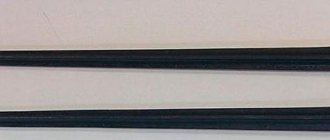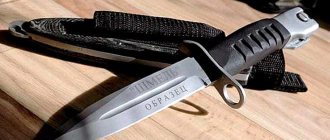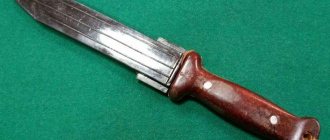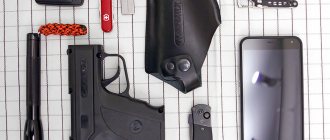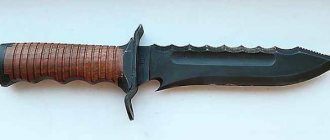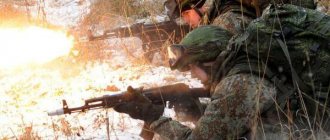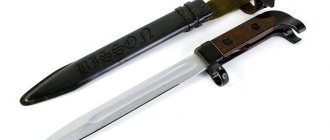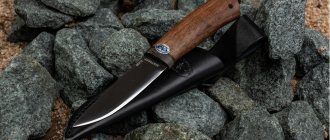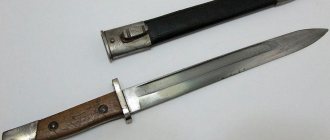AK-47 bayonet with scabbard - (photo)
The bayonet for the Kalashnikov assault rifle did not immediately appear on the first model. The weapon was made without additional “canopies”. And only three years after the AK-47 assault rifle was adopted by the Soviet army, it was equipped with a bayonet.
Active military operations suggested that soldiers often had to face the enemy at a short distance, where they had to fight hand-to-hand, including using a machine gun as an assault weapon, without having time to use it for its intended purpose. Therefore, the designers developed a blade that is highly durable and is mounted on the barrel of the machine gun using a ring.
AK-47 bayonet with scabbard - (photo)
It should be noted that by that time there was already a bayonet for weapons such as the Mosin rifle and Degtyarev machine gun.
Double-sided blade
The first bayonet knives were sharpened on both sides, which made knife fighting easier. The blade width of 30 millimeters increased the cutting qualities of edged weapons. And the handle itself had a limiter (guard), which did not allow the hand to slip onto the tip of the blade.
AK-47 bayonet (photo)
The bayonet-knife was removed from the barrel with a slight movement, and instantly turned into a weapon separate from the AK-47. The designers, taking into account the specifics of military operations, distributed the weight of the steel so that the blade also served as a throwing weapon. According to military archives, many sentries and guards were killed using a bayonet during World War II. The scouts hid their weapons, removed the knife from the barrel, and quietly cleared the territory.
AK-47 with bayonet (photo)
With its help they also took “tongues”, as in the films, putting cold steel to the throat. Few resisted, feeling the sharp edge on their necks. The slightest movement and the bayonet cut the throat. And then during special operations the blade was used more than once.
The bayonet was also used on the AK-47 itself. This increased the distance of close combat, which gave a head start to a soldier trained in fighting with a machine gun.
What does the law say?
According to the laws of the Russian Federation, bayonet knives with the following characteristics are recognized as edged weapons:
- blade length – from 9 centimeters;
- blade material – steel with a hardness of 42 HRC;
- sharpened blade;
- butt thickness from 2.7 to 6 millimeters;
- the depth of the notch, the finger stop is more than 4 millimeters.
You can carry and store edged weapons only with a special license, having previously passed an ownership exam.
To protect yourself from prosecution by law enforcement agencies, in doubtful cases you should submit your blade for examination. Bayonet knives for AKs and SVDs belong to the category of combat edged weapons and are prohibited for use by civilians.
Those who want to have a knife similar in appearance to a combat knife resort to cunning. Reduce the hardness of steel by cutting or tempering. Let us remind you that a bayonet-knife is recognized as a bladed weapon if all the signs specified in the law are present. A certificate for the blade, confirming that it belongs to household products, will help to avoid problems with the police.
The bayonet replaced bayonets on firearms, and for many years helped win the battle when it came to hand-to-hand combat. Despite changes in the methods of warfare, edged weapons remain in demand among experienced fighters; they help out in battle and on vacation, as they are universal and reliable.
Modernization of the bayonet
Initially, the handle of the blade was made of wood, and the total length of the bayonet for the AK-47 was 315 mm, the blade itself had a length of 205 mm and a width of 22 mm. The steel met the best characteristics of that time. But there was an unpleasant moment - with a strong blow, the steel bent, and sometimes the blade broke.
AK-47 bayonet-knives in sheath - original (photo)
In the mid-1950s, the bayonet-knife was modernized by changing the size and blade itself, which made it possible to saw even nails. Now the length of the bayonet-knife was 280 mm, respectively, the blade became 150 mm.
Subsequently, the design was shortened to 260 mm, although the blade was 10 mm longer. When used separately from the AK-47, the bayonet-knife began to “sit” confidently in the hand, since the handle was equipped with transverse thickenings and was made of impact-resistant plastic with a steel tip. Thus, the knife was used to cut electrical wires without fear.
Original AK-47 bayonet (photo)
The scabbard was originally produced in a steel version with a leather belt attachment. And then they were equipped along the entire length with a layer of plastic, a dielectric. Previously, a leather version of the scabbard was also used.
AK-47 bayonet handle and leather sheath (photo)
In order for the bayonet to fit any Kalashnikov assault rifle, the mount on the barrel was not modified. Therefore, old models can easily be installed on a modern AK 47.
Army knife 6X9
Army knife 6X9
The 6X9-1 bayonet is designed for:
defeating and destroying enemy manpower and service dogs using muscular force by contact blow or throwing, as well as when placed on small arms; disabling elements of enemy equipment and equipment. cutting through non-hardened steel wire with a diameter of up to 3 mm.
In this episode, viewers will see the most modern edged weapons of the Russian army.
Combat knives of underwater saboteurs, a shooting knife, a set of survival equipment “Elf” for special forces. But the main character of our film will be the army knife of the “Warrior” set. In terms of reliability and combat properties, it surpasses all its previous analogues. To clearly prove this, we will tell and show the evolution of the knife over the last thousand years. But the most important thing is that we will conduct a unique experiment. In the field, using a homemade furnace, using 10th century technology, we will forge a real blade from scrap metal, modeled after a warrior’s knife. We will conduct severe strength tests for him and the “Warrior” knife, and then we will give both of them a military acceptance test.
The 6X9-1 bayonet, which is part of the "Ratnik" combat equipment, was created by KAMPO JSC, one of the oldest enterprises in the military-industrial complex, a developer and serial manufacturer in the field of instrument making for aviation, astronautics, medicine, diving, fire fighting and emergency rescue. services, as well as shipbuilding and the production of bladed weapons.
The 6X9-1 bayonet is designed to defeat and destroy enemy personnel and service dogs using muscular force using a contact strike or throwing method, as well as when placed on small arms, to disable elements of enemy equipment and equipment, and to cut through steel and non-hardened wire. diameter up to 3 mm.
In terms of its shape, the blade of the 6X9-1 bayonet is of the clip-point type with double-sided symmetrical sharpening and short fullers to make it easier. This choice of blade shape was dictated by the customer’s requirements, who wanted the knife to be able to penetrate a 6B23 type bulletproof vest with an impact energy of 40 J to a depth of at least 20 mm. The peculiarity of the blade is a stepped, variable descent with different sharpening angles. This idea was suggested to the developers by the famous knife designer I. A. Skrylev.
The blade is coated with a titanium-based nano-composite coating, which has high hardness and wear resistance. The surface of the blade has a special treatment to reduce unmasking glare. The blade has a differentiated sharpening of the cutting edge.
The compact sheath of the 6X9-1 bayonet knife is made of impact-resistant plastic with a device for cutting steel wire and a diamond stone for straightening the cutting edge.
The 6X9-1 bayonet is attached to the “Ratnik” equipment using a sheath, which is equipped with a fastening element on the belt and hip, as well as a universal mount for fixing on combat equipment.
The 6X9-1 bayonet can withstand a load applied to the middle of the handle when the blade is secured along the entire length - at least 100 kg.
Technical characteristics of the bayonet-knife 6X9-1: Time to remove the knife from the sheath – no more than 2 s; Knife weight – no more than 270 g; Weight of the knife with sheath and fastening elements – no more than 700 g; Overall dimensions of the knife with sheath – no more than 330x70x35 mm; Knife length – no more than 281 mm; Blade length no more than 162 mm; Blade width no more than 30 mm; Blade thickness 5 mm; Blade steel - 95Х18 with hardness 54...58 HRC.
The joint-stock company KAMPO in the town of Orekhovo-Zuevo near Moscow, specializing in the creation of breathing apparatus for pilots, cosmonauts, divers and firefighters, has been participating in the Ratnik R&D project since 2010. As part of this program, which is an analogue of the Western “Soldier of the Future” programs, KAMPO is developing a new combat knife 6X9 and a new bayonet 6X9-1 for the armed forces of the Russian Federation. Details of the design of the new knives have not yet been officially disclosed and will be published only after the completion of state tests.
The knife is equipped with a guard (crosshair), one of the ends of which is bent towards the butt, to parry the blows of the enemy’s knife, as well as better support for the thumb during delicate work. The molded plastic handle is ergonomically shaped and secured with a rivet. At the end of the handle there is a steel spike used for breaking glass.
The knife is equipped with a plastic sheath and a hanger made of durable fabric, which allows you to attach the knife in different ways to a soldier’s uniform. The scabbard has been equipped since the 60s with a wire-cutting device, traditional for Soviet bayonets-knives, invented in 1956 by Lieutenant Colonel R.M. Todorov. However, unlike its usual version, which involves the use of a blade, both halves of the “cutters” of the 6X9 knife are completely mounted on a sheath, such as, for example, the HPS, NRS-2 scout knives and their non-firing versions. In this case, the knife blade is not weakened by the hole for connecting to the sheath and becomes stronger. This is extremely important for a military knife, for which the military places extremely high demands in this regard - for example, the knife blade should not break even when throwing the knife into a brick pattern. However, I would like to note that the usefulness of this device is rather doubtful. Firstly, cutting so-called NATO barbed wire with this device is impossible. Second: today there are not so many tactical situations where a soldier needs such a tool, and if he does need it, it is better to use more suitable means. And finally, thirdly, a device for cutting wire makes the sheath heavier and more complex, which leads to an increase in the cost of the entire knife. Also somewhat surprising is the presence of a silver shiny blade, which is not typical for modern tactical knives that have a matte black or sometimes even camouflage finish. This coating prevents the formation of bright reflections and contributes to better camouflage of the knife owner. The 6X9-1 bayonet is unified with the 6X9 knife and differs only in the presence of a ring on the guard and a modified shape of the handle, which is necessary for attaching it to small arms.
Of course, the development of the knife has not yet been completed and it has not yet reached its final form. So it is quite possible that a number of critical comments will be taken into account by the developers of the knife. Moreover, KAMPO’s previous developments in the field of special knives were very successful, which gives reason to hope for the ultimate success of the 6X9 and 6X9-1. Moreover, from the experience of previous developments of Russian combat knives, it follows that after purchasing a batch of knives for law enforcement agencies, as a rule, commercial versions in the form of hunting, tourist or survival knives enter the civilian market. So lovers of hunting and outdoor activities, as well as collectors of bladed weapons, just have to be patient and wait with interest for the outcome of such an interesting development.
Interest in bayonets
Gun lovers are often interested in purchasing old models of the product. And they wonder what a cut on a bayonet is. As you know, an AK-47 blade is a bladed weapon, and its possession carries criminal penalties. It is generally accepted that if the blade at the base is sawn through 2/3 of the depth, then such a bayonet-knife is considered “deactivated” and unsuitable for use, and this specimen can be used in your collection.
AK-47 bayonet with a cut - photo
But that's not true. Each bayonet for an assault rifle has a number and is assigned to a specific military unit. The weapon has not yet been removed from service, and even with a cut, the original bayonet-knife cannot be kept by a private person. Well-connected collectors cannot always obtain a license from the hunting inspectorate for a real bayonet-knife, even with a cut, until its origin is explained.
AK-47 bayonet - cut (photo)
Interest is also fueled by the functions of the bayonet knife. According to weapons experts, the capabilities of the AK-47 blade are superior to its analogues. With a knife you can saw iron, cut live wires, unscrew bolts and even chop wood. This is not to mention its special capabilities, for which it was created - use in battle.
Product requirements
Melee weapons remain popular and in demand among combatants. Requirements for bayonet knives that developers try to implement in their models:
- comfortable shape and handle, safe for owners;
- a blade that can inflict a serious wound, and then easily remove the weapon and continue the attack;
- the ability to use only one hand - the second remains free;
- versatility of use;
- Convenient fastening that does not interfere with movement and eliminates loss.
As strategists prepare for wars involving missiles and drones, the era of hand-to-hand combat is believed to be a thing of the past. But those who do not plan, but actually participate in combat clashes, for example, the US Marine Corps, are in no hurry to abandon bayonet knives.
Design Features
The first bayonet was called a 6x2 product. It was put into service in 1955. Despite the fact that in the drawing the model looked like a bayonet, the design made it possible to use it as an army knife.
Since the first machines did not provide for the installation of additional devices, they had to be modified during scheduled repairs. Design features of the model:
- Single-edged blade. It had the shape of a spear and was equipped with fullers to facilitate the design.
- Riveted handle. Plastic covers were attached to it with a pair of screws.
The device was firmly fixed on the trunk:
- On the muzzle using a ring on the cross.
- On the stop of the gas chamber there is a T-shaped groove with a spring latch located in the head of the handle.
The total length of the bladed weapon is 315 mm, blade dimensions are 205x22 mm. Additionally, the bayonet-knife was equipped with a steel sheath. They were equipped with a loop and a strap for fixing on the belt.

